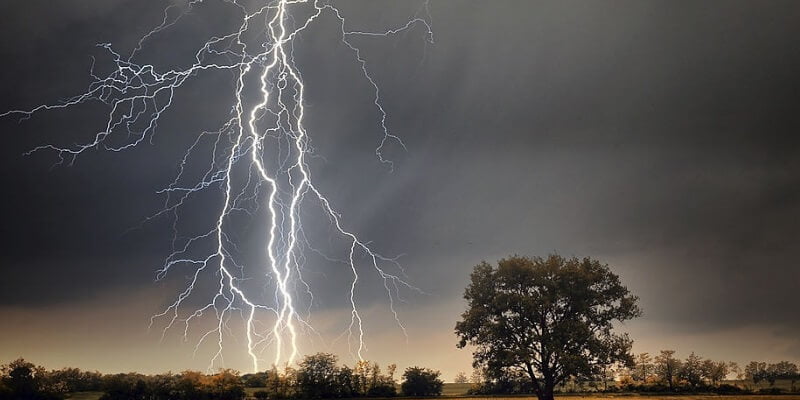
Camping amidst a thunderstorm can be a thrilling yet potentially hazardous experience for outdoor enthusiasts. Thunderstorms are usually accompanied by strong gusts of wind and heavy rain. In this situation, anyone who is outdoors is at risk.
In our detailed guide, we’ll share what to look out for when camping in thunderstorms. We will also introduce you to good behavior and basic equipment so that you can turn a stormy night into an awe-inspiring memory that lingers in your outdoor repertoire for years to come.
10 Basic Tips for Camping In Thunderstorms!
Let’s see 10 pro tips for camping in thunderstorms step by step…
1. Recognize the danger in good time
Before heading out, check the weather forecast for the area where you’ll be camping. If thunderstorms are predicted, consider postponing your trip or choosing a safer location.
Apps such as the warning weather app let you know when a storm is approaching your campsite. If the distance between lightning and thunder is less than 10 seconds, the risk of a lightning strike in your area is very high. The danger is over only 30 minutes after the last thunder.
2. Go to shelters
When the thunderstorm approaches, it is best to go to a building on the campsite with a lightning rod! Or a closed car. Because you are safe here. Vehicles with metallic bodies form a Faraday cage that protects the occupants. If no shelter is available, try to find a low-lying area away from tall objects like trees or cliffs, as lightning tends to strike higher objects.
3. Avoid raised and open areas
That is why the proximity of building walls, high-voltage lines, large festival tents, metal flagpoles, and rock walls offer you protection from being caught by lightning yourself. However, keep a distance of at least three feet to avoid jumping over the lightning bolt.
Do not stay in open fields, on hilltops, or near bodies of water during a thunderstorm. These areas are more likely to attract lightning.
4. Keep away from individual tree
Trees can literally explode when lightning strikes! So keep a distance of 10 meters from them. Otherwise, you will be endangered by falling branches and flying bark. Isolated trees are often hit by lightning strikes. Staying in a forest with trees of the same height promises protection.
5. Minimize contact with the ground
Because electricity spreads through the ground after a lightning strike: During a thunderstorm, minimize contact with the ground by keeping your feet close together. Do not touch any bystanders either!
6. Use quality tent to protect against wind and rain
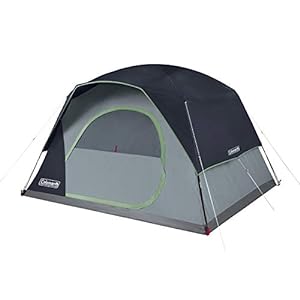
A normal tent does not block lightning but protects you from wind, rain and cold. If no lightning-protected room is available, crouch on a non-conductive surface in the middle of your tent. For example, a dry air mattress or sit on a backpack and keep your feet close together here too.
7. Bring the right equipment
With sturdy pegs that are suitable for the ground under your tent, you can tension the tent so that it is windproof. Secure your pavilion from thunderstorms with storm lines. Don’t hold him by lightning and thunder! After a thunderstorm, you can quickly repair damage to your tent with a repair kit.
8. Choose a good location for your tent
Do not pitch your tent on a hill or near solitary, tall trees. Small sinks are not good either: They quickly fill up with water in heavy rain. A slight slope is better, on the side facing away from the wind. The tent’s entrance points away from the wind.
9. Don’t be a lightning magnet
If lightning-protected rooms and your tent are not within reach, do not be at the highest point in the area yourself. Avoid hills, get off your bike, and get off your umbrella! The best thing to do is to crouch in a depression with your feet together and pull your head in.
10. Avoid water activities
Water is a good conductor of electricity. If lightning strikes a body of water, the electrical current can travel through the water, potentially posing a danger to anyone in or near the water. Boats, especially those with metal components, are at a higher risk during a thunderstorm. Swimmers are also at risk due to their proximity to the water’s surface. So avoid swimming or boating during a thunderstorm.
Now you know basic and proven behavior that increases your safety when camping in a thunderstorm. Next, you should look at some important pieces of equipment that will help you get through the storm.
Basic Equipment for Camping in Thunderstorms
In the following sections, we’ll explore the specific equipment you should consider bringing on a camping trip where thunderstorms are a possibility.
Robust tent pegs
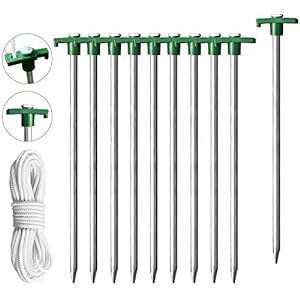
Eurmax Galvanized Tent Stakes are made of solid steel and withstand tensile forces in strong winds without bending or even breaking. Because of the T-shaped handle, the storm line holds even if the peg turns in the ground. The round cross-section makes it easier to hammer into hard and stony soils. If the ground is softened by rain, the screw thread improves the hold. The order also includes bonus 4’10” Ropes and 1 Green Stopper.
Groundsheet
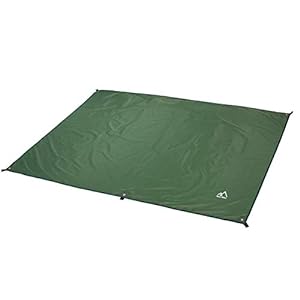
An additional groundsheet protects your tent floor from sharp objects such as branches and small stones. This prevents water from entering the tent from below. Groundsheet also improves the insulation against ground currents in the event of lightning strikes. Because the tent is not in the mud, cleaning up after the storm is made easier.
We recommend the fabric Hiker Camping Tarpaulin from Terra, which is one of thweathe more stable tarpaulins and reinforced edges.
IOS or Android Apps

The app from the weather service warns you of impending storms and natural hazards such as floods, storm surges. The app is available free of charge from Google Play and the Apple App Store.
AccuWeather is known for its reliable and accurate weather forecasts. The app can provide timely alerts for thunderstorms in your area. This early warning can give you valuable time to prepare, seek shelter, or even consider adjusting your camping plans if necessary.
Seam sealer

If the seams of your tent have become leaky after a violent storm, you can easily seal them with a seam sealer. Small cracks and holes in the tarpaulin, the tent floor, air mattresses, and shoes can also be repaired in this way. For PU tents, we recommend the proven GEAR AID Seam Grip TF Tent Fabric Sealer, which is simply applied to the inside of the damaged area.
Guy ropes
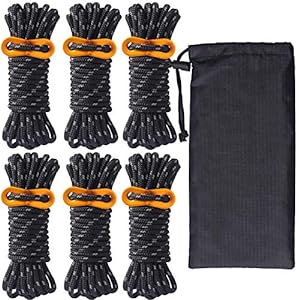
Standing outside during a thunderstorm and holding the iron bar of the pavilion in your hand with your arms stretched out – that’s pretty much the most dangerous thing you can do during a thunderstorm. It is better to secure your pavilion in good time before the storm.
Hikeman Guy Lines Tent Cords Rope consists of 6 guy ropes, each 4 meters long. It comes with pre-assembled three-hole tensioners and peg loops. That makes tensioning quick and easy.
Now you know the most important pieces of equipment that will help you stay dry and warm in storms and rain. With the right equipment and the basic rules of conduct in your luggage, you are already well prepared. However, the more you know about thunderstorms, the better you can take care of yourself and others.
Frequently Asked Questions
How dangerous is camping in a thunderstorm?
Thunderstorms are dangerous to anyone who is outdoors. Lightning is hotter than the sun. Most of the time, lightning strikes a person on the head. This leads to serious injury or death. A normal tent is usually irreparably destroyed. The temperature of lightning is up to 30,000 degrees Celsius – five times as much as the surface of the sun. The result is severe burns.
Lightning strikes extremely high currents of up to 400,000 amperes. If such a high flow of current flows through a person, it leads to unconsciousness, coma, and fatal cardiac and respiratory arrests.
The voltage of lightning is up to 50 million volts Therefore, a normal tent offers no protection. A lightning bolt that struck several kilometers of air easily penetrated the tent shell and the groundsheet.
How do I protect myself from direct lightning hits?
You have exactly two options: Be in a place that is protected from lightning or stay in a place where lightning doesn’t strike. Don’t pitch your tent in these places! Lightning strikes in raised areas. Therefore, avoid ridges, hills and banks. Also, do not tent on flat surfaces, where the tent is the only raised point in the wide area.
What is a good place for my tent in a thunderstorm?
Good places for your tent are valleys, flat slopes and wide valleys. Make sure that water can drain from your campsite. A forest with trees of about the same height also promises protection. Nearby objects that clearly protrude beyond your tent also protect you from direct lightning hits. However, this exposes you to the dangers of a close hit.
Which objects promise protection when camping in thunderstorms?
Building walls, high-voltage lines, large festival tents, metal flagpoles and rock walls, as well as ledges, offer you protection from being struck directly by lightning.
Here are some objects that can offer protection:
- The highest possible security is buildings. If you somehow have the option, find a building with a lightning protection system. On campsites, these are the reception and sanitary buildings. Sometimes there are refugees in sports facilities and in nature. You are safe here. Even massive buildings without lightning rods offer some protection. Warning: high seats are usually neither lightning-proof nor massive!
- Perfect protection is cars: Closed vehicles with metallic bodies form a Faraday cage that directs lightning around the occupants into the earth. You are also safe in RVs with a metallic outer shell and in the driver’s cab of mobile homes. Convertibles and RVs with plastic walls, however, do not offer sufficient protection.
- Faraday thing is great: I still have a roll of wire mesh that matches my tent in color… We have already heard several stories from campers who have turned their tent into a Faraday cage with an attached lightning catcher using aluminum poles, wire mesh, and meter-long telescopic flagpoles. It had nothing to do with serious lightning protection. If you don’t have an earth rod with you that you can drive nine meters deep into the ground: don’t do it. Really.
- Tents with lightning protection: Some specialized tents are designed with lightning protection features, such as conductive frames or coatings that help disperse electrical charges safely into the ground.
- Caves or rock overhangs: Natural formations like caves or rock overhangs can offer some shelter from rain and wind, but they may not provide complete protection from lightning.
- Avoid isolated trees and tall objects: If no shelters are available, stay away from isolated trees, tall objects, and open fields. These are more likely to attract lightning.
How you can tell if a thunderstorm is coming your way?
Count the number of seconds that pass between lightning and thunder. If the time gets shorter, the thunderstorm draws towards you. There is already a danger if 30 seconds pass between lightning and thunder. At 10 seconds, the probability of a lightning strike is greatly increased. 30 minutes after the last thunder, the danger is over.
- Tips: If you divide the time in seconds between lightning and thunder by three, you get the distance of the lightning strike in kilometers.
How do I protect myself from nearby affects?
- Avoid metal objects: Lightning creates strong magnetic fields. They create a flow of electricity in metal objects around them. That can happen even at a distance of 50 meters. Therefore, it is best to bring hiking sticks out of the tent before the thunderstorm and store them under a tree, protected from the rain. Also, remove the power cables from the tent! Stay away from construction fences at festivals and away from pasture fences in nature.
- Minimize contact with the ground: Because electricity spreads through the ground after a lightning strike during a thunderstorm, minimize contact with the ground by keeping your feet close together and only touching the ground with your feet.
- Do not lie on the floor: Then a lot of electricity can flow through your body. Leave shoes on. Do not touch any bystanders either! Ground currents occur up to a distance of 30 meters around the lightning strike.
- No lightning protection system on the tent? Stay in the middle: When staying in buildings without a lightning protection system and in your tent: Stay in the middle of the room if possible. Do not touch walls or tent poles!
- Find insulating ground: To minimize the risk from ground currents, get on a well-insulating surface. In your tent, this can be a sleeping mat or your sleeping bag. Outside, asphalt, dry wood, and granite work well. Meadows and damp earth conduct electricity well and should therefore be avoided. Make sure to keep the inside of your tent dry! If you have water in your tent, try to build an island out of air mattresses and sleeping bags.
- Individual trees are dangerous: Trees can literally explode when lightning strikes! Therefore, keep a distance of 10 meters from individual trees. Do not expose yourself to the danger of falling branches and flying bark. Individual trees, small groups of trees, and trees on the edge of the forest are often hit by lightning strikes. Trees in a closed forest are much safer.
- Immediately back on land: Get out of the water as soon as possible. Lightning spreads over a great distance in the water and even a brief loss of consciousness can lead to drowning. If you are traveling by boat, anchor as quickly as possible when the thunderstorm approaches. On the water, the boat is at the highest point in the area!
- First aid for victims of the lightning strike: Move the victim out of the greatest danger area, for example away from a tree that has been hit. As with all electrical injuries, even if there are no external signs, the injury can be very serious. Therefore, alert the emergency services immediately! Check the vital functions and initiate resuscitation measures in the event of respiratory or cardiac arrest. Keep the victim warm and dry until emergency services arrive.
- Don’t run … jump: It’s dangerous to run in a thunderstorm. If your feet touch the ground in two places far apart, more current will flow through your body when lightning strikes nearby. The best way to get around during a thunderstorm is therefore to hop with your legs together!
Conclusion
Camping in thunderstorms offers a unique opportunity to experience the raw power of nature. By following the right strategies and having the essential equipment on hand, you can turn a potentially hazardous situation into a memorable adventure.
we’ve explored the key tips and equipment necessary for safe camping during thunderstorms. From reliable weather forecasting apps like AccuWeather to the importance of seeking proper shelter, each recommendation is aimed at enhancing your safety and comfort in adverse weather conditions.
Stay informed about the weather, have a solid plan in place, and be ready to adapt to changing conditions. With the right mindset and the right gear, you can confidently face the challenges and make the most of your camping experience, even in the midst of a thunderstorm. Happy camping!
Happy camping!